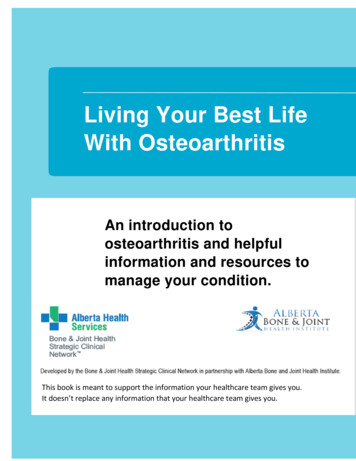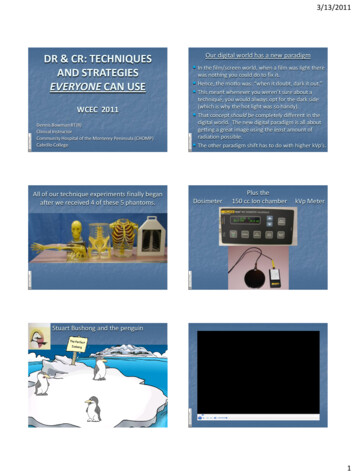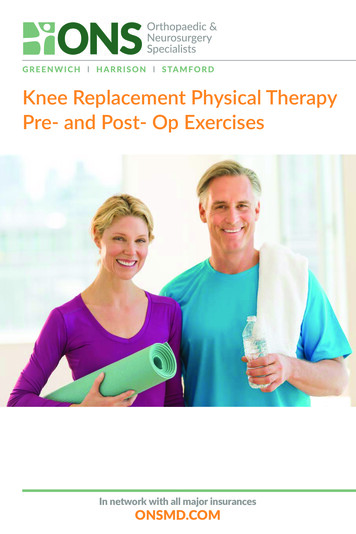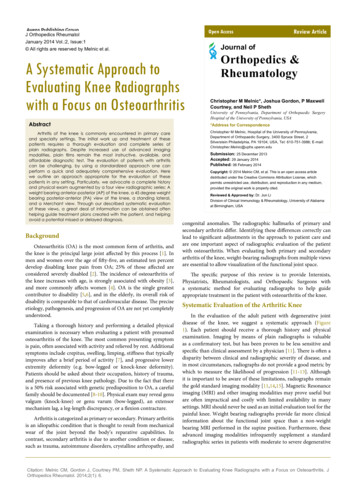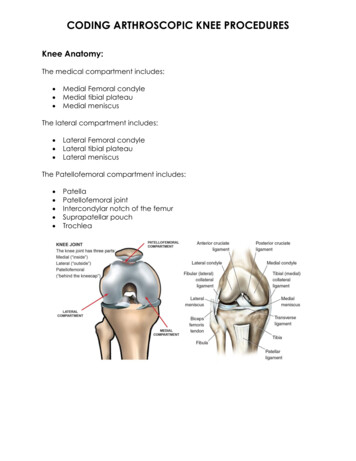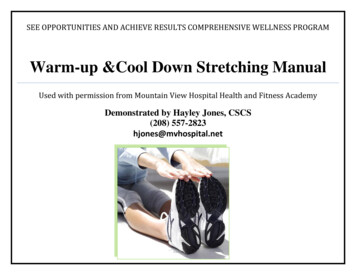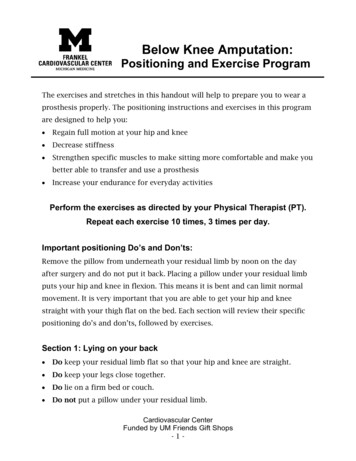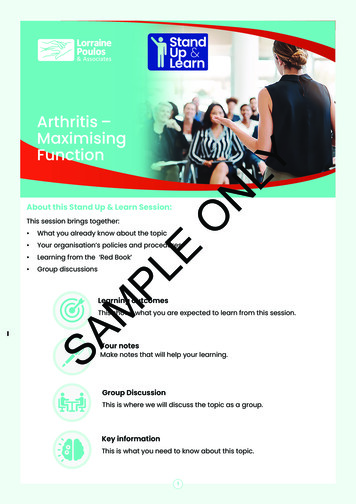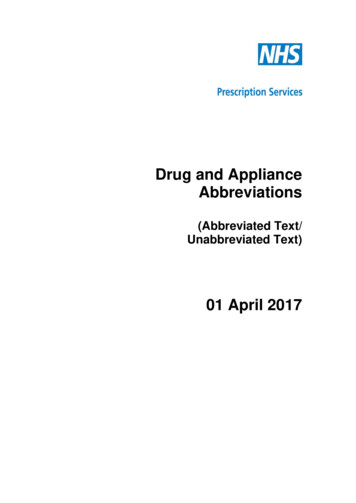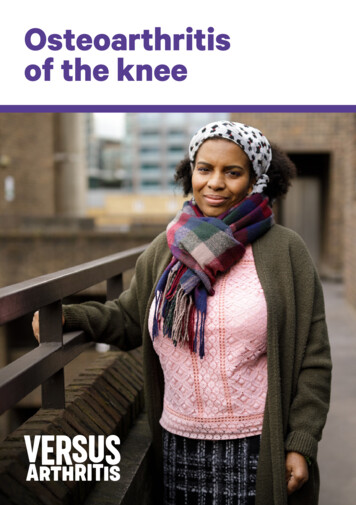
Transcription
Osteoarthritisof the knee
ContentsWe’re the 10 million people living with arthritis. We’re the carers,researchers, health professionals, friends and parents all united inour ambition to ensure that one day, no one will have to live withthe pain, fatigue and isolation that arthritis causes.We understand that every day is different. We know that what worksfor one person may not help someone else. Our information is acollaboration of experiences, research and facts. We aim to give youeverything you need to know about your condition, the treatmentsavailable and the many options you can try, so you can make thebest and most informed choices for your lifestyle.We’re always happy to hear from you whether it’s with feedback on ourinformation, to share your story, or just to find out more about the workof Versus Arthritis. Contact us at content@versusarthritis.orgRegistered office: Versus Arthritis, Copeman House, St Mary’s Gate, Chesterfield S41 7TDRegistered Charity England and Wales No. 207711, Scotland No. SC041156.What is osteoarthritis of the knee?4How will it affect me?7Managing osteoarthritis of the knee9Exercises for osteoarthritis of the knee18Where can I find out more?22Talk to us23
What is osteoarthritis of the knee?Osteoarthritis (os-tee-o-arth-ri-tus) is the most common form ofarthritis, and the knee is one of the most commonly affected joints.Everyone’s joints go through a normal cycle of damage and repairduring their lifetime, but sometimes the body’s process to repairour joints can cause changes in their shape or structure. Whenthese changes happen in one or more of your joints, it’s knownas osteoarthritis.A joint is a part of the body where two or more bones meet – in yourknee, it’s the thigh and shin bones. There is also a small bone at thefront of the knee called the patella or kneecap.The ends of our bones are covered in a smooth and slippery surface,known as cartilage (car-ti-lidge). This allows the bones to moveagainst each other without friction, and protects your joint from stress.Your knee also has two other rings of a different type of cartilageknown as menisci or meniscus, which help to share weight evenlyacross your knee joint, and there’s also cartilage underneath yourkneecap.Osteoarthritis causes the cartilage in your knee joint to thin andthe surfaces of the joint to become rougher, which means that theknee doesn’t move as smoothly as it should, and it might feel painfuland stiff.Figure 1. A healthy knee usCapsuleTendonFigure 2. A knee joint with mild osteoarthritisOsteophytes(bony itis can affect anyone at any age, but it’s more common inwomen over 50.Injuries or other joint problems, such as gout, can make people morelikely to get osteoarthritis. The genes we inherit from our parents canalso increase the risk of the condition developing.Being overweight is also linked to osteoarthritis, as this causes extrastrain on weight-bearing joints, such as your knees.4versusarthritis.orgFor more information on the conditions above, see theVersus Arthritis booklets: Osteoarthritis; Gout. You canview all our information online at www.versusarthritis.orgHelpline 0800 5200 5205
How will it affect me?If you have osteoarthritis of the knee, you will probably feel your kneeis painful and stiff at times. It may only affect one knee, especially ifyou’ve injured it in the past, or you could have it in both. The painmay feel worse at the end of the day, or when you move your knee,and it may improve when you rest. You might have some stiffness inthe morning, but this won’t usually last more than half an hour.The pain can be felt all around your knee, or just in a certain placesuch as the front and sides. It might feel worse after moving yourknee in a particular way, such as going up or down stairs.Sometimes, people have pain that wakes them up in the night.You’ll probably find that the pain varies and that you have goodand bad days.You might find you can’t move your knee as easily or as far asnormal, or it might creak or crunch as you move it.Sometimes your knee might look swollen. This can be caused bytwo things: Hard swelling: when the bone at the edge of the joint growsoutwards, forming bony spurs, called osteophytes (os-tee-o-fites). Soft swelling: when your joint becomes inflamed and producesextra fluid, sometimes called an effusion or water on the knee.Sometimes osteoarthritis of the knee can cause the muscles in thethighs to weaken, so your leg may look thinner. This weakness canmake the joint feel unstable and could cause the knee to give waywhen you put weight on it.The effects of osteoarthritis can make people feel depressed oranxious, and it can affect relationships and sleep. If you have anyproblems like this, mention them to your doctor as there are thingsthey can do to help.6versusarthritis.orgHelpline 0800 5200 5207
Are there any complications?Osteoarthritis can develop over just a year or two, but more often it’sa slow process over many years that only causes fairly small changesin just part of the knee.But in some cases, the cartilage can become so thin that it no longercovers the ends of the bones. This causes them to rub against eachother and eventually wear away.The loss of cartilage, the wearing of the bones, and the bony spurscan change the shape of the joint. This forces the bones out of theirnormal positions, making your knee feel unstable and painful.Some people with osteoarthritis find a lump appears at the back oftheir knee. This is called a Baker’s cyst or popliteal cyst.A Baker’s cyst is a fluid-filled swelling at the back of the knee thathappens when part of the joint lining bulges through a small tear in thejoint capsule. This can then cause joint fluid to be trapped in the bulge.It can happen on its own, but is more likely in a knee that’s alreadyaffected by arthritis. A Baker’s cyst doesn’t always cause pain, butsometimes it can burst so the fluid leaks down into your calf, causingsharp pain, swelling and redness in the calf.Osteoarthritis in the knee might change the way you walk or carryyour weight, and this could cause you to develop the condition inother joints, such as your hips.For more information on symptoms and outlook of thiscondition, see Versus Arthritis booklet: Osteoarthritis.You can view all our information online atwww.versusarthritis.orgManaging osteoarthritis of the kneeThere’s no cure for osteoarthritis, but there are things you can do foryourself that can make a difference to how the condition affects you.There are also some treatments available that could significantlyreduce your pain.ExerciseJoints need to be exercised regularly to keep them healthy. It’s veryimportant to keep moving if you have osteoarthritis of the knee.Whatever your fitness level, exercise helps the knee to be able tocope with normal daily activities again.You’ll need to find the right balance between rest and exercise –most people with osteoarthritis find that too much activity increasestheir pain while too little makes their joints stiffen up. Exercise can8versusarthritis.orgHelpline 0800 5200 5209
strengthen the muscles around your knee, improve your posture andhelp you to lose weight, all of which can reduce the symptoms andpain of osteoarthritis.It’s important to carry on with your exercises even if you start to feelbetter, as stopping or reducing the amount of exercise you do couldcause your symptoms to come back again. A physiotherapist canadvise you on the best exercises to do, but you’ll need to build theminto your daily routine to get the most benefit from them.You’ll need to find the right balancebetween rest and exercise – too muchactivity may increase your pain while toolittle makes the joints stiffen up.Your physiotherapist may recommend exercise in a hydrotherapypool. This can help get muscles and joints working better and,because the water is warmer than in a normal swimming pool, it canbe very soothing and relaxing. Hydrotherapy is sometimes calledaquatic therapy.Swimming and exercising in water can be helpful if your joints arepainful, as the water takes the weight of your body which reducesany strain on your knees, but still lets you keep moving. It’s importantto balance this with weight-bearing exercise as well, such as walking,as this will help to keep your bones strong.There are various types of exercise that have been proven to helptreat osteoarthritis of the knee.Range of movement exercisesThese are good for posture and helping to keep your joints flexible.These exercises can be something as simple as stretching, makingsure your joint moves through a range of positions that comfortablystretch its reach and flexibility slightly further each time.Strengthening exercisesThis type of exercise is important to improve the strength of themuscles that control your knee, and to help stabilise and protect thejoint. It’s also been shown to reduce pain and can prevent your kneegiving way, reducing the risk of falls.You should try to do strengthening exercises on at least two days aweek if you can.Aerobic exerciseAerobic exercise is any exercise that increases your pulse rate andmakes you a bit short of breath. Regular aerobic exercise can helpyou in many ways. It’s good for your general health and well-beingand can reduce pain by stimulating the release of pain-relievinghormones called endorphins. It can also help you sleep better.10versusarthritis.orgHelpline 0800 5200 52011
Different types of aerobic exercise include cycling, swimming andwalking. You should work hard enough to get out of breath but stillbe able to have a conversation.You should try to do 2 hours and 30 minutes of aerobic exerciseeach week. You can spread this out over the week and don’t needto do it all in one go.Weight managementBeing overweight increases the strain on your joints, especially yourknees. It makes it more likely that you’ll develop osteoarthritis andthat your arthritis will get worse over time.Losing weight if you’re overweight could reduce your pain and othersymptoms of osteoarthritis of the knee. The force put through yourknees when you walk, run or go up and down stairs can be two orthree times your body weight, so losing even a small amount ofweight can make a big difference to the strain on your knees.12versusarthritis.orgThere’s no special diet that will help with osteoarthritis, but if youneed to lose some weight you should follow a balanced, reducedcalorie diet combined with regular exercise. Your doctor should beable to give you advice on diets and exercise that will help.Keeping to a healthy weight isespecially important if you haveosteoarthritis of the knee.Reducing the strain on your kneesApart from keeping an eye on your weight, there are a number ofother ways you can reduce the strain on your knees. Pace your activities – don’t tackle all your physical jobs at once.Break the harder jobs up into chunks and do something gentler inbetween. Keep using your knee even if it’s slightly uncomfortable,but rest it before it becomes too painful. Wear shoes with thick soles and enough room for your toes.Wearing the right shoes can reduce the shock through your kneesas you walk and prevent any changes to your feet. If you need extra support for your feet or knees when you walk,speak to your physiotherapist, occupational therapist or doctorabout getting insoles made for your shoes. Use a walking stick if needed to reduce the weight and stress ona painful knee. An occupational therapist can advise on thecorrect length and the best way to use the stick. Use a handrail for support when going up or down stairs.Go upstairs one at a time with your good leg first. Think about making changes to your home, car or workplaceto reduce unnecessary strain. An occupational therapist canadvise you on special equipment that will make things you doevery day easier.Helpline 0800 5200 52013
Using a heat pack or something similar on a painful knee might helpto relieve the pain and stiffness of osteoarthritis. An ice pack can alsohelp but be careful not to put ice or heat packs or hot water bottlesdirectly on your skin – wrap them with a tea towel or cover.Some people find that knee braces help. You can buy knee bracesfrom sports shops and chemists, but you should speak to your doctoror physiotherapist first, as they might be able to provide braces orrecommend the best one for you.Coping with low mood and sleep problemsYou might find that osteoarthritis of the knee makes you feeldepressed or anxious. Speak to your doctor if you’re feeling low asthey may be able to recommend psychological therapies to helpyou, such as cognitive behavioural therapy (CBT) and stressrelieving techniques.If your sleep is disturbed because of osteoarthritis of the knee, thiscould make your pain feel worse. However, there are things you cando for yourself that might help, such as: Keep a sleep diary to work out if there are any patterns to yoursleep problems. Sleep at regular times to get your body into a routine. Avoid phones and other screens in the bedroom to help you winddown before bed.If you’re still having problems, speak to your doctor or anoccupational therapist who can give you other tips and techniquesto try, known as sleep hygiene.DrugsDrugs can be used to help ease the pain and stiffness caused byosteoarthritis, but they won’t prevent or cure the condition itself.You’ll have the best results if you keep active, reduce the strain onyour knees, and take drugs for your condition as you need them.Some of the drugs and treatments you can try include: Painkillers: simple over-the-counter painkillers such asparacetamol may help, but your doctor may prescribe youstronger painkillers if needed. Non-steroidal anti-inflammatory drugs (NSAIDs): a shortcourse of NSAIDs, such as ibuprofen, can help reduce any pain,inflammation and swelling in your knee. Capsaicin cream: a pain-relieving cream made from the pepperplant, available on prescription. Steroid injections: an injection directly into the knee joint, whichcan help reduce swelling and pain.14versusarthritis.orgHelpline 0800 5200 52015
If you’re taking any of the over-the-counter medications mentionedabove, make sure you’re taking them safely and as directed by yourdoctor or the patient information leaflet included with the drug. Makesure whoever is treating you knows all the medications you’re taking.See Versus Arthritis booklets: Osteoarthritis; Painkillersand NSAIDs; Steroid injections. You can view all ourinformation online at www.versusarthritis.orgOther pain reliefIf the methods of pain relief above don’t help you, you might want totry some of the following: Transcutaneous electrical nerve stimulation (TENS): a smallmachine that changes the way nerves understand pain by sendingtiny electric shocks through pads placed on your skin. Hyaluronic acid injections: hyaluronic acid occurs naturally inthe body and helps to lubricate joints. These injections aren’tavailable on the NHS as they’ve not been proven to be effective,but you may be able to get them privately. Complementary treatments and supplements: some peoplewith osteoarthritis find glucosamine and chondroitin helpful, butyou should talk to your doctor before you start taking anythingnew, as there isn’t a lot of research to show that these are helpfuland they may interact with some prescribed drugs.For more information on the treatments above, seeVersus Arthritis booklet: Osteoarthritis. You can view allour information online at yExercise, treatments and keeping to a healthy weight usuallyimprove the symptoms, pain and ability to do daily activities in mostpeople with osteoarthritis of the knee. But if these treatments haven’tworked for you, you may benefit from having surgery on your knee.Surgery might be suggested if your pain is very severe or if you haveproblems getting around or moving your knee.The most common type of surgery for osteoarthritis of the knee isa knee replacement. Many knee replacements are performed eachyear, and the operation can give a lot of pain relief and improvemovement in your knee.Knee replacement surgery isusually very successful, but noteveryone will need it.Surgical techniques are improving all the time and research hasshown that up to 8 in 10 knee replacements could as long as25 years. However, as with all surgery, there are some risks andyour surgeon will want to make sure you’re in the best healthpossible before the operation.Sometimes keyhole surgery techniques may be used to wash outloose fragments of bone and other tissue from your knee. This is calledarthroscopic lavage (arth-row-scop-ick lav-arge) or debridement, butit won’t be recommended for you unless your knee locks.See Versus Arthritis information: Knee replacementsurgery. You can view all our information online atwww.versusarthritis.orgHelpline 0800 5200 52017
Exercises for osteoarthritis of the kneeThis section contains some simple exercises that are designed tostretch, strengthen and stabilise your knee.It’s important to keep active – you should try to do some of theseexercises every day. Try to repeat each exercise between 5 and 10 timesand perform the exercises between two and three times each day.Stretching exercises should be done daily, strengthening exercisesshould be done two or three times a week and aerobic exercises shouldbe done between two and five times a week.Muscle stretchLay down with a rolled-up towel under the ankle of your leg. Bend theother leg at the knee. Use the muscles of your straight leg to push theback of your knee firmly towards the bed or the floor. Hold for a slowcount of five.Repeat at least five times with each leg. This exercise helps toprevent your knee from becoming permanently bent. Try to do this atleast once a day when lying down.Start by exercising gradually and build up over time. Carry on exercisingeven if your symptoms ease, as this can stop them coming back.If you have any questions about exercising or if you’re unsure how to doa certain exercise, ask your doctor or physiotherapist before you start.It might help to go through these exercises with a physiotherapist atfirst, or they might be able to give you a personalised exercise plan.Leg stretchSit on the floor with your legs stretched out straight in front ofyou. Slowly bend one knee up towards your chest, sliding your footalong the floor, until you feel a gentle stretch. Hold for five seconds.Straighten your leg as far as you can and hold in this position forfive seconds.Stretching exercisesTry to do these exercises every day.Straight-leg raise (sitting)Sit with good posture in a chair.Straighten one of your legs, hold for aslow count to 10 and then slowly loweryour leg. Repeat 10 times with each leg.Repeat 10 times with eachleg. If you can’t get downonto the floor, sit on a sofaand use a board or tea trayas a surface to slide yourfoot along.If you find you can do this easily,straighten and raise one leg, beforeholding for a count of 10. Try to getinto the habit of doing this exerciseevery time you sit down.18versusarthritis.orgHelpline 0800 5200 52019
Strengthening exercisesThe following exercises might be quite hard to do, so try to do themtwo to three times a week.Step upsStep onto the bottom step of stairs with yourright foot. Bring up your left foot, then stepdown with your right foot, followed by your leftfoot. Hold on to the bannister if necessary.Repeat with each leg until you can’t do any more.Rest for one minute and then repeat this anothertwo times. As you improve, use a higher step.Straight-leg raise (lying)Lay down and bend one of your legs at the knee. Hold your otherleg straight and lift your foot just off the bed or floor. Hold for a slowcount of five, then lower. Do this until you cannot do any more, restfor a minute, then do this a further three times.Knee squatsHold onto a chair or work surface forsupport. Squat down until your kneecapis directly over your big toe. Return tonormal standing.Sit/standsSit on a chair. Without using your hands for support, stand upand then sit back down. Make sure each movement is slow andcontrolled. Repeat until you can’t do any more.Repeat until you can’t do anymore, restfor one minute, then repeat another twotimes. As you improve, try to squat alittle further, but don’t bend your kneesbeyond a right angle.Rest for one minute then repeat another two times. If the chair istoo low, start with rising from a cushion on the seat and removewhen you don’t need it any more.Leg crossSit on the edge of a table, seator bed and cross your ankles. Pushyour front leg backwards and backleg forwards against each other untilyour thigh muscles become tense.Hold this for as long as you can, thenrelax. Rest for one minute and thenrepeat another two times. Switch legsand repeat.20versusarthritis.orgHelpline 0800 5200 52021
Where can I find out more?Talk to usIf you’ve found this information useful, you might be interested inother titles from our range. You can download all of our bookletsfrom our website www.versusarthritis.org or order them bycontacting our Helpline. If you wish to order by post, please seeour address below.Bulk ordersFor bulk orders, please contact our warehouse, APS, directlyto place an order:Phone: 0800 515 209Email: info@versusarthritis.orgYou don’t need to face arthritis alone. Our advisors aimto bring all of the information and advice about arthritisinto one place to provide tailored support for you.Helpline: 0800 5200 520Email: helpline@versusarthritis.orgOur officesTell us what you thinkAll of our information is created with you in mind. And we wantto know if we are getting it right. If you have any thoughts orsuggestions on how we could improve our information,we would love to hear from you. Please send your views tobookletfeedback@versusarthritis.orgor write to us at the following address:Versus Arthritis, Copeman House, St Mary’s Court,St Mary’s Gate, Chesterfield, Derbyshire S41 7TD.Thank you!A team of people helped us create this booklet. We would like tothank Tim Cook, Dr Anish Kotecha and Mary McAllister for helpingus review this booklet.We would also like to give a special thank you to the peoplewho shared their opinions and thoughts on the booklet. Yourcontributions make sure the information we provide is relevantand suitable for everyone.22Helplineversusarthritis.orgWe have offices in each country of the UK. Please get in touchto find out what services and support we offer in your area:EnglandTel: 0300 790 0400Email: enquiries@versusarthritis.orgScotlandTel: 0141 954 7776Email: scotland@versusarthritis.orgNorthern IrelandTel: 028 9078 2940Email: nireland@versusarthritis.orgWalesTel: 0800 756 3970Email: cymru@versuarthritis.orgHelpline 0800 5200 52023
Osteoarthritis of the kneeOsteoarthritis is the most common form of joint disease. In this bookletwe explain what it is, how it develops and how it’s treated. We also givesome hints and tips on managing osteoarthritis of the knee in daily life.For information please visit our website:versusarthritis.org0300 790 is Versus Arthritis 2020VA2027
known as cartilage (car-ti-lidge). This allows the bones to move against each other without friction, and protects your joint from stress. Your knee also has two other rings of a different type of cartilage known as menisci or meniscus, which help to share weight evenly across your knee joint, and there's also cartilage underneath your kneecap.
